COCHITUATE RAIL
TRAIL
(Natick and Framingham,
Massachusetts, USA)
by A. Richard Miller,
Chairman Emeritus
Natick
Bicycle and Pedestrian Advisory Committee
visits since
970926; last updated 090430.
|
UPDATE by A. Richard
Miller (January 10, 2017)
2003: "The
Cochituate Rail Trail may open as early as 2005 in
Framingham and 2007 in Natick."
It might have happened. But the 1.5-mile section in
Framingham didn't get built until 2015, with a
ribbon-cutting in May of 2016. And the long-abandoned
2.4-mile section in Natick remains abandoned because CSX,
owner of the abandoned right-of-way (ROW), is greedy and
Natick was talked out of taking the matter to court.
Although its predecessor rail operators had taken much of
their corridors by Eminent Domain, and acquired the rest
at low values under the threat of Eminent Domain takings -
all for the over-riding purpose of public
transportation - CSX has prevented this rail
trail from offering public transportation to and from the Natick Center
commuter-rail station to Boston and Worcester for lo,
these many years.
On Wednesday
evening, January 11, 2017 in Natick, a Mass-DOT hearing
will be held on a CSX-proposed acquisition at great
cost - both in dollars and in future wrongs both here and
for other rail-trail projects near and far. This rotten
deal would reward CSX with $6.071M for its abandoned 21.94-acre
ROW. That's more than profitable, working ROW, and
far, far more than comparable abandoned single-track
ROW that couldn't turn a profit. (It comes to
about $277K per acre or $2.530M per mile, about
five to seven times what other local rail-trail
projects have recently been negotiating with CSX.)
This inflated price was determined by pretending that this
narrow strip of contaminated property is comparable to the
highest-valued adjacent (and wide, buildable)
property. (The Framingham section was acquired in 1990 for
a fairly-appraised $100,000; that would be $184,500 in
2015 dollars, and the equivalent value of the Natick
section is $295,000. That's still less than 1/20th
of $6,071,000! Abandoned-rail-corridor real-estate may
have appreciated faster than the dollar, but not nearly that
much.) Incredibly, a clause in the proposed purchase and
sale agreement would require Natick to provide $275,000
worth of advertising about "the great generosity of CSX in
offering it for only $6.071M." And why? Another
clause stipulates that CSX has greatly reduced its asking
price from $11M "as a charitable gift". If Natick does
applaud that bogus "generosity", it will pave the way for
a CSX tax break here (which tax-payers end up subsidizing)
and will create a crippling precedent for similar
price-inflation and obstruction on its - and other
railroads' - ROW transactions across the nation.
The proposed trail design also maximizes
construction costs (and already has spent over
$500,000 on design costs), economizing only by
narrowing down this
potentially-busy transportation corridor to 12 feet
from its previously-recommended 14-foot width.
(The development work for the trail appears to be
about three times more than on other good trails
- and that's without the cost of the bridges.)
(Note: My calculations and statements are based upon
public information, which can vary. I welcome more
accurate information.)
I will be unable to attend this hearing in person. Will
the current TrumpThink that has our nation about to build
an expensive wall across its Mexican border when it
"cannot afford" to maintain its failing road
infrastructure and bridges, similarly impel Natick and
Massachusetts to buy into this expensive boondoggle by CSX
and its local spokesmen? If so, will Mass. DOT aid and
abet that destructive course? Hopefully, others will be
there to speak out to defeat this proposal and to demand a
sensible one!
A more courageous committee can then organize other rail
trail groups, State and Federal agencies, and politicians
to acquire this public-transportation solution at a
favorable price despite the great greed of CSX (and build
it to 14-foot width, at prevailing costs). Should CSX
refuse, Eminent Domain has never been more appropriate. (A
current Federal Rail-Banking agreement precludes that on
the main trail, but it expires this April. The
"Wonderbread Spur" already is proposed for an Eminent
Domain taking at no cost.) There is no need, and a great
harm to be had by agreeing, to be held hostage by the
current owner of this failed railroad operation.
|
The Cochituate Rail Trail may open as early
as 2005 in Framingham and 2007 in Natick. A new role for the
old Saxonville Branch Industrial Railroad
corridor, the CRT's
"Tunnel of Green" will serve as the
four-mile-long trunk of an extended trail network for pedestrians,
bicyclists and other non-motorized users. From downtown Natick's
commuter rail station, library, restaurants and The Center for
Arts in Natick, past Pegan Cove Park,
Natick Labs (U.S. Army Soldier Systems Center), Lake
Cochituate and the Cochituate State Park day-use area (with boat rentals and swimming), a greatly-expanded Natick Mall and the
adjacent "Golden Triangle" shopping and office buildings, the
corporate headquarters for T.J. Maxx, the American Cancer Society
and 500 Old Connecticut Path, and the trout-fishing in Cochituate
Brook, to the historic district of Saxonville with the new Amazing
Things Arts Center and the Carol J. Getchell Nature Trail, the CRT
will connect a phenomenal combination of recreation, business,
shopping, and greenway opportunities, while reducing or
eliminating significant alternative-transportation obstacles in
our populous communities.
History:
The railroad might have come through South Natick, which hotly
pursued that goal. But Natick Center won out and became heavily
developed. Reaching west from Boston, the Boston and Worcester
Railroad was serving Natick in 1834 and Worcester in 1835. West of
downtown Natick, this route passes Lake Cochituate just north of
Route 135, between Fisk Pond and the south end of South Pond.
Later extensions and corporate mergers grew this into the main
route from Boston to Albany and all points west. (In 1895, the
Massachusetts rail system looked like this.)
In 1846 the Saxonville Branch Line was run north
four miles from Natick, along and across Lake Cochituate. One can
imagine that the Mass. Legislature's commitment that same year to
build Cochituate
Reservoir for Boston was a great incentive to the start of
this spur line. The new line indeed was utilized for much hauling
of construction materials, equipment and manpower. However, train
traffic between the large Saxonville Mills (later Roxbury Carpet
Company) and Natick's own booming community and the railroad main
line would have been incentive enough.
In 1973 Roxbury Carpet closed its mills, as the
textile industry moved to the American South. Now the Saxonville
Branch RR track only reaches north from downtown Natick through Cochituate State Park and alongside Lake
Cochituate almost to Route 30, just west of the entrance to the
day-use area of Cochituate State Park. North of Route 30 (and
the Natick/Framingham town line), the right-of-way remains intact all the way
up to the Sudbury River in Saxonville (northeast Framingham), but
tracks and ties have been removed. Framingham has been negotiating
multi-use trail easements with the current stewards of that
defunct right-of-way: the Massachusetts Turnpike Authority and the
Massachusetts Bay Transportation Authority.
Disappearing Freight Use:
The Saxonville Branch Line's major recent user was a once- or
twice-weekly freightcar exchange at Continental Baking Company's
"Wonder Bread plant" (across Speen Street, just north of the
Natick Mall). As early as 1996, we predicted the imminent
elimination of the Wonder Bread factory; Interstate Bakeries
Corporation's acquisitions of Continental, J.J. Nissen and other
bakeries had left it with too many no-longer-competing
factories, and the current real-estate value of this site
(adjacent to the Natick Mall, largest mall in New England) made
it an extraordinarily expensive place to bake bread and
Twinkies. In December 1998, Continental confirmed that the plant
closure would occur about mid-1999, and it did close that June.
In late 1999 a NYC firm bought the site and remodelled the
Wonder Bread building to become a Tech Commons "data hotel",
filled with a lot of computer data storage and a few
technicians. But that plan fell through with the "dot-com"
bubble and the property again changed hands.
In 2000, the Town of Natick removed the rails
crossing Speen Street; that spur ROW remains for future trail
use. Natick has an easement to extend that trail along the north
and west perimeters of the old Wonder Bread site, and is
including major multi-use trail design as part of the Natick
Mall expansion project.
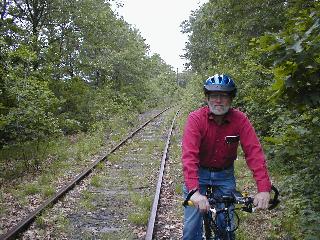 |
| From the RR
bridge over Route 9 in Natick, the green view north
toward Route 30 and Saxonville. An important urban goal:
Preserving great views and that green screening! |
Also in 1998, Conrail sold vast New England
railroad holdings to CSX, including the Boston-to-Albany main
line and this Saxonville spur line. Closer to Lake Cochituate on
that same short side track, the only remaining CSX freight
customer is new: S & D Meats/Metro Freezer and Storage. On
Chrysler Road near Lake Cochituate, it shares a building with a
child day-care center and averages less than one train visit per
week (often at night).
So now the once-busy and lovely Saxonville Branch
Line is little used. Rails and the lake shoreline are
poorly maintained. Trains run at walking speed, which is
just as well; even so, in one year beginning October 2000 there
were three at-grade collisions of a locomotive with a vehicle at
Lake Street in Natick, and one of these collisions demolished a
truck! Trains are expected to cease their traffic through
Cochituate State Park in 2006, and the Towns of Framingham and
Natick are planning accordingly.
Natick Mall Expansion:
Currently, Chicago-based General Growth
Properties, the owner of Natick Mall, has acquired this adjacent
site and proposes to greatly enlarge Natick Mall so much
that it probably will become the largest mall in New
England! They proposed to also include a hotel, then changed
that to two apartment towers, and, in 2005, proposed to
include the apartment towers and a hotel! Furthermore, modified
plans have also been submitted to build as a separate mall -- as
a way to confound Macy's lease-guaranteed veto of competing
stores (specifically, Neiman Marcus and Nordstrom's). So Natick
(and adjacent Framingham) may get the integrated mall that was
planned, or two separate ones, and with an ever-growing list of
add-in projects. It has, to say the least, been time-consuming
and confusing for the local review agencies.
Through 2003, the Natick Mall Expansion
proponents avoided working with local and regional groups
regarding its link to the CRT. At the end of 2003, that was a
key reason that its Draft Environmental Impact Report (including
a proposed hotel) was found deficient by the Mass. Environmental
Policy Act Office (MEPA). Through 2004, the CRT groups were
slightly included, but their minimum design goals were not met;
at the end of 2004, the resulting Final Environmental
Impact Report (now with two still-unplanned residential towers
instead of the hotel) was still judged inadequate by MEPA. The
NBPAC and other groups asked the Natick Planning Board (a)
to include at least one local-trails-savvy consultant and (b) to
include at least one nationally-prominent design group to add a
new level of bike-ped design savvy to its own planning review
team for this project, and also (c) to request (again) that
MassHighway swing its own bike-ped experts onto this important
regional project. The only part of that which was delivered was
a walking consultant (without bicyclist-design skills), and this
failed to achieve better agreement.
In December 2004, MEPA wrote re the Natick Mall Expansion
project:
The proponent should be diligently working with the proponents
for the rail trail to find a mutually agreeable alternative to its
proposed at-grade, activated, signal-protected crossing of Speen
Street to connect the portion of project site's pedestrian/bicycle
trail to the Cochituate Rail Trail. The Proposed Section 61 Finding
for MHD should update the discussion on this topic, as well as
provide some preliminary cost estimates of a grade-separated
crossing of Speen Street for the proposed rail trail connector. It
should also identify if the pedestrian/bicycle trail on the project
site can be widened to 12 feet with two to three-foot shoulders as
recommended by the AASHTO guidelines and the proponents for the rail
trail."
(MEPA's full text is online at:
http://www.millermicro.com/NatickMallFEIR-MEPACert041230.pdf
)
The proponent and the Natick Planning Board ignored that
requirement until April 2005, when EOTC made it clear that the
project would not get a State permit for curb cuts until the
conditions were met. As of June 2005, two working meetings have
been held to consider alternate crossings of Speen Street; the
other issues have yet to be discussed.
Other Regional Rail Trails:
A few towns to the north, the Minuteman
Commuter Bikeway through Bedford and Lexington to
Arlington is an excellent example of new usage for a retired
rail line. Any nice weekend day finds its eleven paved miles
teeming with bicycles, skaters and folks out for a walk.
Once-skeptical neighbors find it far better than train traffic
or idle disuse; good for relaxation, health, and property
values. Other Massachusetts bikeways are in use and on the
drawing boards across the Commonwealth (see MassBike,
Mass.
Highway Dept., multi-use
trail
projects map) and beyond (Rails-to-Trails Conservancy,
Trails and Greenways
Clearinghouse). Rail trails can even coexist with busy
rail lines, so either a slightly-used or abandoned Saxonville
Line can serve.
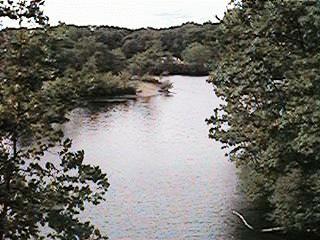 |
| From the
notched RR bridge just north of Route 9, the view
southwest over Carling Pond to the boat tunnel at Route
9 (once the historic Willow Bridge). |
The Proposed Cochituate
Rail Trail:
The Cochituate Rail Trail will utilize this Saxonville Branch
Line roadbed to give downtown Natick a recreational route north
along Lake Cochituate and to the day-use area of Cochituate State Park, plus car-free bike
and pedestrian access over major highways to the very popular
Natick Mall. The northern extension -- along the west bank of
Cochituate Brook and up to meet Route 126 at the Sudbury River
-- will provide the same advantages to cyclists and pedestrians
from Saxonville and other communities north of the Massachusetts
Turnpike. The entire path offers a protected, varied, lovely and
functional four-mile bike and walking trail -- an incredibly
untouched route through a very urbanized highway network. (See CRT map.)
The Cochituate Rail Trail's trailhead in
Saxonville is only a few blocks from where the Carol Getchell
Nature Trail (created in 2000) runs downstream along the Sudbury
River, and only a mile from another wonderful trail being
planned along the no-longer-used Weston Aqueduct, on which
Callahan State Park lies another 3.3 miles to the west.
A western, "Bannister's Meadowland" branch for the
Cochituate Rail Trail has been proposed, stretching west to extend
the Wonder Bread spur line right-of-way past the Natick Mall and
the General Cinema complex to Shoppers World in Framingham. This
could be routed alongside the existing circular roadway, but the
Framingham Conservation Commission and others are exploring how it
can be routed through the large, central wild area -- Bannister's
Meadowland, which supports many birds, plus deer and beaver -- for
greatly enhanced separation and natural beauty. The Natick
Conservation Commission is exploring another western route, from
Natick Mall southwest to the signalized Route 9 crossing to Natick
Promenade (until 2004, Loews Theaters) and beyond. Wetland
preservation groups work to add boardwalks in such areas;
shopping-mall owners and Town agencies have expressed general
support for a similar project here. A large number of adjacent
hotels, office buildings, bicycle dealers, and others also can
help their communities and themselves by pitching in. While final
plans must wait, the Natick Planning Board proactively establishes
easements along the way.
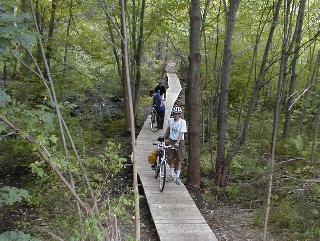 |
| Walking bikes
along the new boardwalk on the Snake Brook Trail. |
An eastern branch, the Snake Brook Trail, was built
in 2000, and connects via a walking trail through Cochituate Brook
Reservation. It runs east from Cochituate Dam, on Lake
Cochituate's North Pond in Framingham and just across Cochituate
Brook from the main Cochituate Rail Trail, to Route 27 on the
Natick/Wayland town line, just south of downtown Cochituate. In
Sept. 2000, Matt Linehan's Eagle Scout project laid a boardwalk
that opened its Route 27 end for public use. A logical future
extension east to Wayland's Lower Snake Brook Conservation Area is
under consideration by the Wayland Conservation Commission. A
footbridge over Cochituate Brook or a path along it, linking the
Snake Brook Trail with the Cochituate Rail Trail, is a logical
western tie-in project for Cochituate State Park and the
Framingham Conservation Commission. The western section of the
Snake Brook trail, from Cochituate Dam east to Route 30 at the
north side of the Massachusetts Turnpike, is open to hiking and
biking. The eastern section, also on wild land owned by Cochituate
State Park, is open to hiking and may be improved for biking
later. CSP has provided trail signs on the roads. Entrance stairs
from Route 27 and some bridge improvements are to be provided by
CSP; they were expected by Summer 2001.
Many thousands work along the proposed Cochituate
Rail Trail; of them, hundreds would find it useful for bicycle
commuting to work, and many more would use it for local
shopping trips, noontime biking, jogging and strolling. It also
serves thousands of residents
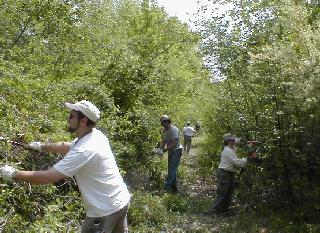 |
| May 12th,
2001: With loppers and shears, CRT volunteers remove a
decade of brush and greenbriar to reveal the trail. |
along its route. For less local users, convenient
automobile parking -- as well as food and other facilities -- is
available near both ends and the middle. The Mass. Dept. of
Environmental Management supervises other hiking and bike paths.
Cochituate State Park staffers already are proficient at that;
they also manage Callahan State Park, where hiking and biking
are major attractions.
A year of our local efforts to organize resulted
in late-1998 requests from the Selectmen of Framingham and
Natick -- and support from the Mass. Dept. of Environmental
Management -- to study the feasibility of converting this spur
line from railroad use to recreational and alternate
transportation use. In March 1999 metropolitan Boston's Central
Transportation Planning Staff received authorization to
begin that study, and delivered its Reconnaisance
Study of the Saxonville Branch Right-Of-Way in January
2000. In general, it said the Framingham section north of Route
30 could be developed easily, while conversion of the Natick
section was delayed by continuing train usage. It did not
consider the two side branch options in depth.
Access to the already rail-free Framingham
section is being jointly pursued by the Town of Framingham and
the Mass. Dept of Environmental Management. Current owners are
the Mass. Bay Transportation Authority (MBTA)
![Trail cleared to Route 30,
October 2001. [Click to enlarge.]](CRT-Rte30a.jpg) |
| October 20th,
2001: In the eighth CRT clean-up day of the year, CRT
volunteers complete initial Framingham trail-clearing
from School St. south to Route 30 (where this
encroaching wall also is to be moved out). |
north of the Massachusetts Turnpike, and MassPike
from there south to Route 30. Unfortunately, MassPike plans to
sell off all of its 60-80'-wide right-of-way to adjacent
companies, so they can extend their buildings and parking lots
close to a remaining 18'-narrow trail easement. Instead of a
linear park, MassPike would leave little more than an alleyway,
with bicycle-unfriendly curves between extended parking lots,
fences, and possibly new buildings. Keeping the wider ROW, with
plenty of trees and brush for good linear-park screening and
straight view lines, is a major rail-trail priority. A May 2001
Massachusetts Legislative Report, Getting
On
Track: Common Sense Ideas to Expedite Rail Trail Development
in Massachusetts, urges the free transfer of public
open spaces to appropriate government agencies. The report
specifically mentions this trail (on its pages 14-16/footnotes
75-79). MassPike has not yet joined the other agencies that
subscribe to that policy, so in July 2001 we issued an appeal for help, with further
discussions in 2002.In October 2000, Mass. DEM (now DCR) awarded
a $20,000 grant to the Town of Framingham, to clear that
northern section of the CRT and to stabilize and redeck its
rusting bridges. A first trail-clearing day, on May 12th, 2001
(the first day of Massachusetts Bike Week), saw 45 volunteers
open most of the trail from School Street south to the
Massachusetts Turnpike. By fall, further improvements were made
and the trail was extended to Route 30, the entire 1.3 miles in
Framingham. One short stretch just northwest of Old Connecticut
Path will require a detour until the two old railroad bridges
can be redecked, but in August 2001 MassPike awarded a $100,000
![Moving the encroaching
wall, July 2002. [Click to enlarge.]](020712CRTwall.jpg) |
| July 12th,
2002 (looking back from Route 30): The old encroaching
wall is being removed. For now, a lower, straight one
(foreground) is being built along a staked line -
still well inside the CRT ROW. |
tourism grant to the Town of Framingham for that
and more. We still await interim (pre-transfer) general-use
permissions from MBTA and MassPike.
To celebrate the opening of a first section of
the Cochituate Rail Trail and to increase public awareness,
"CRT-shirts" were donated by The MathWorks, Inc. of Natick. They
are on sale for $10 each (to benefit CRT projects) at REI in
Framingham. A new CRT brochure also was designed and became
available in December 2001. (Brochure printing is made possible
by a gift from REI. Text is by A. Richard Miller. The CRT logo and CRT brochure design
are volunteer contributions of commercial artist Steve Broadley,
and the map editing is by Tom Branham.)
A proposed commuter-rail parking garage, on South
Avenue in downtown Natick, would tie in well for bicycle
commuters using this rail trail. The Massachusetts
Bay
Transportation Authority has begun to implement
multi-modal improvements. Diverse groups (Town of Natick, MassBike, MassBike/MetroBoston)
are urging the MBTA to include inside, visible, safe and free
bicycle parking here -- an incentive to shift more commuters
from parking their cars in busy downtown Natick, as it uses the
train to reduce car pressures in downtown Boston. West of
downtown Natick, Middlesex Path connects to the CRT via Pegan Cove Park,
![Discussing
commuter-rail parking garage. [Click to enlarge.]](crt-BirminghamMagnanithumb.jpg) |
| August 27th.
2001: At proposed site for commuter-rail parking garage,
NBPAC Chair Dick Miller and Natick Director of Community
Development Sarki Sarkisian explain the proposed
CRT-to-MBTA Commuter Rail linkage to Mass. Senate
President Tom Birmingham and Mass. Senator Dave Magnani. |
Natick's downtown
waterfront park on Lake Cochituate's South Pond.
A walk along this railway now is lovely, and the
improvements will make it exquisite -- a linear park,
well-screened from the bustle just beyond. Natick and Framingham
and Cochituate
State
Park are blessed with this gift from the Age of Rail.
Natick's Selectmen have appointed a Natick
Bicycle
& Pedestrian Advisory Committee, and Framingham's
Selectmen have appointed a Framingham
Bicycle & Pedestrian Advisory Committee and, as
detailed plans became necessary, a Framingham Cochituate Rail
Trail Committee. At the June 2000 Lake Cochituate Annual
Meeting, Massachusetts Secretary of Environmental Affairs Bob
Durand and Commissioner of Environmental Management Peter Webber
committed their high-level resources. Local legislators who
support Cochituate State Park and the Cochituate Rail Trail
include Framingham's State Representatives Debby
Blumer and Tom
Sannicandro, Natick's State Representatives David
Linsky and Alice Peisch,
and State Senators Karen
Spilka and Scott
Brown. They, and through them, the
Metrowest Legislative Caucus and other legislators, are helping
to install effective bicycle parking inside the proposed garage.
Most of them, and many others, have provided strong support
letters for the transfer of MassPike's full-width
corridor. If you support these projects, let them (and us) know!
Natick
Bicycle and Pedestrian Advisory Committee (NBPAC)
John
Magee, Chairman (1-508-720/3439).
A.
Richard Miller, Chairman
Emeritus and Assoc. Member (1-508/653-6136, 9am-9pm; TheMillers@millermicro.com;
http://www.millermicro.com/crt.html).
Monthly meetings: Normally in Natick Police
Conference Room on first Mondays, 7-9pm.
See special NBPAC events and related events online.
You are invited to subscribe to the free Natick bike-ped e-mail list.
The NBPAC was founded in 1997, recognized by the
Natick Selectmen in 1998, and reconfirmed in 2001 with seven
voting Members (plus non-voting Associate Members). The purpose
of the committee is to make
Natick more bicycle and pedestrian friendly and to work
with Town and regional agencies and local organizations to those
ends. The committee serves as a facilitator of State and Federal
funded improvements for alternate transportation, for
recreational trails, and for street crossings and sidewalks in
Natick.
The committee also sponsors public talks and
promotes the Cochituate Rail
Trail (along with the Natick
Cochituate Rail Trail Task Force, Framingham CRT Committee,
Framingham BPAC, and Cochituate State Park Advisory Committee), a trail along the Sudbury Aqueduct, two trails
from Natick Center to South Natick, and other
Town and regional trails (along with the
Natick Conservation Commission, Natick Open Space Committee,
Natick Walks, etc.). It leads easy walks and bicycle rides to
feature local routes and recreational areas, channels public
safety suggestions to appropriate agencies, and generally
informs and acts in these interests.
Supportive regional groups include the Massachusetts Bicycle Coalition
(MassBike), the Rails-to-Trails
Conservancy, the League of American
Bicyclists, and WalkBoston.
MassBike's "Your
Guide to Forming a Bike Advisory Committee" is an excellent
reference for many issues confronting groups such as ours.
Key reference materials (some in need of updates) include:
NBPAC Annual Report (for
2006)
MassHighway
Project Development and Design Guidebook (2006)
MA Statewide Bicycle Transportation Plan
(1988)
MA Pedestrian Transportation Plan (1998)
MA
Bike Path System (current and proposed)
This Web page has been created by Dick Miller of the
Natick Bicycle and Pedestrian Advisory Committee and the
Cochituate State Park Advisory Committee. Please e-mail your
comments to him at TheMillers@millermicro.com
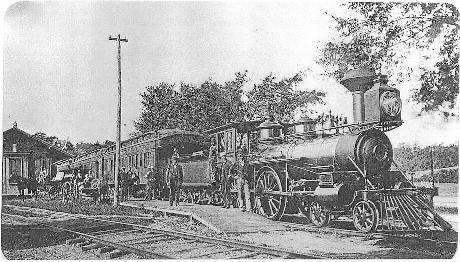




![Trail cleared to Route 30,
October 2001. [Click to enlarge.]](CRT-Rte30a.jpg)
![Moving the encroaching
wall, July 2002. [Click to enlarge.]](020712CRTwall.jpg)
![Discussing
commuter-rail parking garage. [Click to enlarge.]](crt-BirminghamMagnanithumb.jpg)